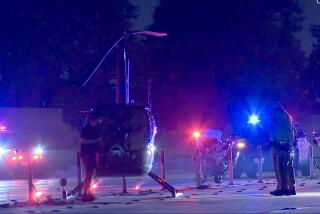Battle over Santa Monica Airport’s future revs up
Does the endgame loom in the decades-long tussle over Santa Monica Airport?
In 2015, all land and building leases at the airport expire, and city officials — and thousands of Westside residents weary of life in the flight path — say the obligation to operate the facility as an airport ends too. Santa Monica has hired consultants to study the 227-acre campus and early next year will begin asking for the public’s input on potential future uses.
The Federal Aviation Administration, meanwhile, asserts that the city must operate the airport in perpetuity under a 1948 “instrument of transfer.” The agency, long a potent adversary on the airport issue, has vowed to stand pat for pilots and passengers.
The dispute could well end up in court. At the least, it is revving up an ongoing battle that has pitted flight-school operators and convenience-loving Westside jet-setters against airport opponents fed up with noise, pollution and plane crashes — most recently in August, when a student pilot in a small plane clipped a tree and plunged into the side of a Santa Monica house. Although many residents embrace the airport for its economic value and its dog park, athletic fields, art galleries and plane-watching opportunities, activists say the risks and disruptions outweigh the benefits.
“A lot of people in the community would really like to see the airport closed,” said Cathy Larson, who lives in Sunset Park at the airport’s western edge. “There are lots of obstacles to achieving that.”
Los Angeles Councilman Bill Rosendahl, who represents Mar Vista, Venice and other neighborhoods surrounding Santa Monica, has dived into the turbulence, citing constituents’ complaints about the aerial meanderings of student pilots in the densely populated area and elevated levels of potentially hazardous particles from jet exhaust and lead from propeller-plane fuel. “The airport doesn’t belong there anymore,” he said. “…There’s no physical buffer between the airport and the lungs of my constituents.”
Santa Monica Airport, established in 1917, is described on a city website as the oldest continuously operating airport in Los Angeles County. After Santa Monica acquired the original 170 acres in 1926, the property became the home of Douglas Aircraft Co., whose DC-3 would introduce average Americans to commercial air travel in the 1930s. At its peak, the company had 44,000 employees, and both Los Angeles and Santa Monica encouraged the building of housing right up to the airport’s perimeter.
Before the United States entered World War II, the federal government leased most of the airport from the city to provide security for Douglas, a major defense contractor. After the war, the federal government returned the improved and expanded property to the city under the “instrument of transfer.”
When jets began using the airport in the 1960s, the city imposed restrictions and, at one point, a total jet ban, which aviation advocates successfully challenged in court in the 1970s. In 1981, the Santa Monica City Council voted to close the airport when legally possible but finally agreed to a 1984 settlement that kept the airport open while imposing strict noise rules.
Amid the booming economy in the early to mid-2000s, the airport saw a dramatic increase in high-powered jets used by the likes of Arnold Schwarzenegger, Tom Cruise and casino magnate Steve Wynn. The number of jet takeoffs and landings has been on the decline since peaking in 2007 at more than 18,500; still, the number last year was more than triple the number in 1993. The overall number of takeoffs and landings — including single- and twin-engine planes and helicopters — has dropped by nearly 30% in the last decade, to 104,950 last year.
In 2007, the city voted to ban high-performance jets with fast landing speeds, including larger and more powerful Gulfstreams, Bombardier Challengers and Cessna Citations. The FAA invalidated the ban, and the city appealed to federal court, which upheld the FAA’s ruling.
“It really ties in with the 1% vs. the 99% issue,” said Martin Rubin, a Los Angeles air-quality activist who has helped lead the charge against the airport. “The 1% are jet-setting in and out of Santa Monica Airport … and polluting the air for a large number of residents.”
One recent afternoon, Virginia Ernst, whose back door is 337 feet east of the runway end, retreated into her home to avoid the fumes of jets idling before takeoff. “I’ve totally lost the use of my yard,” said Ernst, an area resident for nearly 50 years. “It’s like I’m a prisoner in my home.”
On Wednesday, state Sen. Ted Lieu (D-Torrance) will hold a hearing on air quality at Santa Monica Airport at the Felicia Mahood Senior Center Community Room in West Los Angeles.
Mark Smith, a solar energy entrepreneur who keeps his Mooney single-engine plane at the airport and lives in nearby Sunset Park, said the facility has been “a vital tool for operation of my business.” He said he has no patience for complaints about air quality, given the region’s car dependency. “If you’re concerned about pollution in Santa Monica,” he said, “then close down Ocean Park Boulevard and the 10 Freeway.”
Despite the downward trend in airport use, residents’ complaints have soared. Seeking to reduce delays at both Santa Monica Airport and Los Angeles International Airport, the FAA tested a new Santa Monica departure heading, or direction, for six months starting in December 2009. Although the agency assigned the heading to an average of just 10 small, propeller-powered aircraft a day, spokesman Ian Gregor said, “the city forwarded us more than 41,000 noise complaints that residents made.” (Pilots operating under visual flight rules could also choose to use that heading, and those flights accounted for some of the complaints.)
Joe Justice, owner of Justice Aviation, one of six flight schools at the airport, said neighbors “don’t see the upside of the airport — the joy, the sense of accomplishment and the experience of flying.” Justice said residents’ grievances are rising even as the sour economy has slashed business. He said he suspects that real estate agents have led people moving into surrounding neighborhoods to believe that the airport will close in 2015.
“They’re getting more and more frustrated and interpreting it as more and more [air] traffic,” Justice said.
Some residents say closing the flight schools would go a long way toward bringing peace. Santa Monica Councilman Kevin McKeown said the city has been talking with Justice and other schools about relocating some operations to another airport. “The city of Santa Monica might kick in to make it happen,” he said. “That would be immediate relief for people.”
More to Read
Sign up for Essential California
The most important California stories and recommendations in your inbox every morning.
You may occasionally receive promotional content from the Los Angeles Times.











